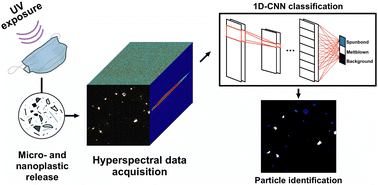Identification of micro- and nanoplastics released from medical masks using hyperspectral imaging and deep learning†
Abstract
Apart from other severe consequences, the COVID-19 pandemic has inflicted a surge in personal protective equipment usage, some of which, such as medical masks, have a short effective protection time. Their misdisposition and subsequent natural degradation make them huge sources of micro- and nanoplastic particles. To better understand the consequences of the direct influence of microplastic pollution on biota, there is an urgent need to develop a reliable and high-throughput analytical tool for sub-micrometre plastic identification and visualisation in environmental and biological samples. This study evaluated the application of a combined technique based on dark-field enhanced microscopy and hyperspectral imaging augmented with deep learning data analysis for the visualisation, detection and identification of microplastic particles released from commercially available medical masks after 192 hours of UV-C irradiation. The analysis was performed using a separated blue-coloured spunbond outer layer and white-coloured meltblown interlayer that allowed us to assess the influence of the structure and pigmentation of intact and UV-exposed samples on classification performance. Microscopy revealed strong fragmentation of both layers and the formation of microparticles and fibres of various shapes after UV exposure. Based on the spectral signatures of both layers, it was possible to identify intact materials using a convolutional neural network successfully. However, the further classification of UV-exposed samples demonstrated that the spectral characteristics of samples in the visible to near-infrared range are disrupted, causing a decreased performance of the CNN. Despite this, the application of a deep learning algorithm in hyperspectral analysis outperformed the conventional spectral angle mapper technique in classifying both intact and UV-exposed samples, confirming the potential of the proposed approach in secondary microplastic analysis.



 Please wait while we load your content...
Please wait while we load your content...